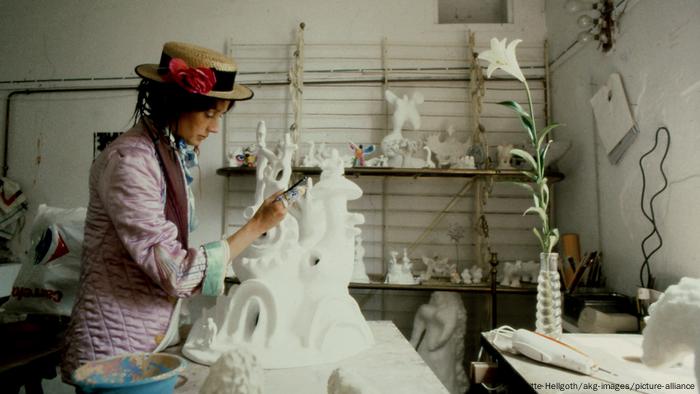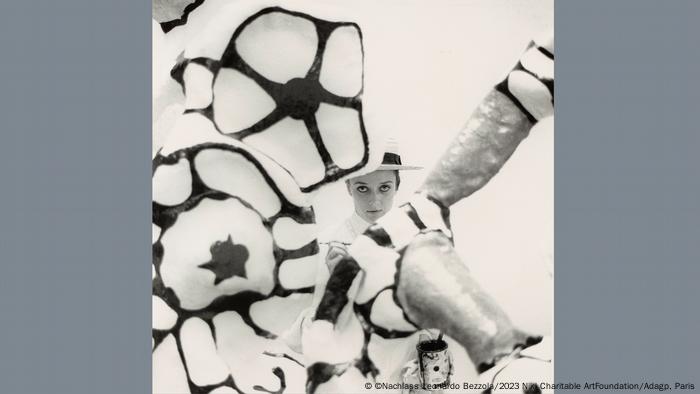Niki de Saint Phalle is known for her brightly colored sculptures of women with voluptuous curves. But they are only part of the seminal work of an artist ahead of her time.

Feminism in art: Niki de Saint Phalle is one of the most important artists of the 20th century
“Niki… ? Nanas… ?  ;Who?' I asked my editor at a loss when writing this story. “Niki de Saint Phalle's name may not sound familiar to you, but I'm sure you know her,” she said. “She's the one who created these colorful sculptures of tall, curvy women”.
And indeed, I knew these figures, which have been printed in magazines and sold in museum shops for decades: the colorful, happy, often pregnant-looking female figures with plump breasts, big buttocks and small heads.

A typical Nana: tall, round, feminine and freedom-loving
For me, they stand for one thing above all: the body of a A woman is a work of art, especially when it doesn't conform to the usual, often patriarchal, notions of form and function.
The figures known as “Nanas” are the trademark of the late French-American artist, sculptor and visionary Niki de Saint Phalle (1930-2002). The name is no coincidence. In French, cheeky young women are called nanas.
I recently had the opportunity to see some sculptures up close at the Schirn in Frankfurt. Highlights from her extensive work are currently being exhibited there. A large poster depicting a Nana enthusiastically throwing her hands in the air hangs at the entrance to the museum. This cheerful display is a pleasant counterbalance to the cloudy and rainy February morning.
Upon entering the exhibition hall, visitors are greeted by a wealth of colour. Decorated in a striking gradient of vibrant fuchsia, royal purple and intense cobalt, the walls provide the perfect backdrop for the works of de Saint Phalle.
As a self-taught artist
Born in France in 1930 to an American mother and a French father, Catherine Marie-Agnès Comtesse Fal de Saint Phalle was a multi-talent who dabbled equally in painting, sculpture, film and performance art.
Self-taught, having previously studied theater, de Saint Phalle turned to painting after being hospitalized in 1953 for a nervous breakdown. After her release, she decided to pursue art more extensively. She once said: “Painting calmed the chaos that stirred up my soul and gave my life an organic structure.”

Niki de Saint Phalle in her studio
In her 1993 memoir, Mon Secret, de Saint Phalle revealed that she was sexually abused by her father as a child. This shed new light on her work, particularly her 1973 feature film 'Daddy', in which a father figure is killed, and also her nanas, which are seen as symbols of free spirit and breaking with societal conventions.' /p>
“Men seem to have much more freedom in their roles, and I have strived to gain that freedom for myself, too,” she once wrote.
The Woman Who Shot Pictures
Niki de Saint Phalle was also a pioneer of performance art. In the 1960s she provoked her so-called “shooting pictures”. To put it in today's words: It went viral back then – without any social media.
In front of an audience, she shot paint bags with rifles or pistols that were embedded in white plaster reliefs, triggering color explosions. who completed their works. She often invited her audience, which included fellow artists, to take the first shot.
De Saint Phalle, who also modeled and graced the covers of Life, Elle, and Vogue magazines, often wore a white jumpsuit in her performances. One of these jumpsuits, along with her “bleeding” artwork, is in the Frankfurt exhibition.

Niki de Saint Phalle attracted a lot of attention with her “shooting pictures”
p>
With her “shooting pictures” de Saint Phalle broke the boundaries in a male-dominated art scene and became one of the most important artists of her generation.
“She uncompromisingly disregarded the rigid social conventions of her time and the prevailing rules of the art world. Her artistic urge to create was fed by anger against a society permeated by patriarchal structures, which she declared war on with her open-hearted, provocative work,” explained Katharina Dohm, curator of the Frankfurt exhibition, in a press conference.
Art with discarded objects
Niki de Saint Phalle also created assemblages and landscapes from used everyday objects. She created works of art from broken dishes, razor blades, gloves or plastic objects. Inspired by contemporary art, she experimented with different techniques, such as in her work “Nightscape” (1959). To do this, she used a dripping technique invented by the American expressionist Jackson Pollock and combined it with the old Moorish mosaic technique of the famous Catalan architect Antoni Gaudì.
In addition, she decided in her works increasingly with the female Identity apart.

Niki de Saint Phalle created feminist art
Although she was not actively involved in the women's movement of the 1960s and 1970s, her artworks often question the social role of women as wives, mothers and sexual objects.
Niki de Saint Phalles Contribution to the women's movement
Inspired by her close friend Clarice Rivers, who was pregnant at the time, she launched her first Nana series in Paris in 1965 and described her larger-than-life figures as a “jubilant celebration of women”.< /p>
Niki de Saint Phalle's Nanas show feminine strength and stand for a liberated matriarchy. Originally made of fabric, yarn and papier-mâché, polyester was later adopted as a material strong enough to allow the larger-than-life figures to be displayed in public spaces around the world.
However, she was doing herself a disservice, as inhaling polyester dust and other toxic fumes released while working on the sculptures led to de Saint Phalle's long-term lung problems and eventual death from respiratory failure in 2002.
Among her many different nanas, “Hon/Elle” could be called the “mother of all nanas”. De Saint Phalle created it in 1966 in collaboration with the Finnish painter Per Olof Ultvedt and her longtime partner and fellow artist Jean Tinguely for the Moderna Museet in Stockholm. A smaller model of the lying, pregnant Nana – through whose vagina visitors could enter a milk bar and a cinema, among other things – can be seen in the exhibition in Frankfurt.

The artist couple Niki de Saint Phalle and Jean Tinguely
“The Nanas say to women: 'My female body is strong… There isn't one Reason to be ashamed of it, no reason to hide'”, explains the curator.
Everyone should be able to live freely
In her art, Niki de Saint Phalle also dealt with socio-political issues: Her works “AIDS, You Can't Catch it Holding Hands (1986)”, “Guns (2001)” and “Global Warming” (2001) deal with them with stigmatization, gun violence and climate change.

With the lithograph “Global Warming” the artist criticized the former US President George W. Bush for his environmental policy
“With her art, she opened a public dialogue about socially relevant issues that still concern us today,” says curator Kathrina Dohm. “We deal We are still concerned with equality between men and women. We deal with issues such as body positivity or body shaming in society. Certain groups in our society are still stigmatized. Their goal was that everyone can live freely .”
The exhibition “Nik i de Saint Phalle” runs until May 21, 2023 at the Schirn in Frankfurt.
This article was adapted from English.